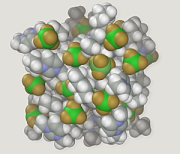
Photo from wikipedia
BackgroundIn general, enzyme activity is estimated from spectrophotometric data, by taking the slope of the linear part of the progress curve describing the rate of change in the substrate or… Click to show full abstract
BackgroundIn general, enzyme activity is estimated from spectrophotometric data, by taking the slope of the linear part of the progress curve describing the rate of change in the substrate or product monitored. As long as the substrate concentrations are sufficiently high to saturate the enzyme and, the velocity of the catalyzed reaction is directly proportional to the enzyme concentration. Under these premises, this velocity can be taken as a measure of the amount of active enzyme present. Estimation of the enzyme activity through linear regression of the data should only be applied when linearity is true, which is often not the case or has not been checked.ResultsIn this paper, we propose a more elaborate method, based on a kinetic modelling approach, to estimate the in vitro specific enzyme activity from spectrophotometric assay data. As a case study, kinetic models were developed to estimate the activity of the enzymes pyruvate decarboxylase and alcohol dehydrogenase extracted from ‘Jonagold’ apple (Malus x domestica Borkh. cv. ‘Jonagold’). The models are based on Michaelis–Menten and first order kinetics, which describe the reaction mechanism catalyzed by the enzymes.ConclusionsIn contrast to the linear regression approach, the models can be used to estimate the enzyme activity regardless of whether linearity is achieved since they integrally take into account the complete progress curve. The use of kinetic models to estimate the enzyme activity can be applied to all other enzymes as long as the underlying reaction mechanism is known. The kinetic models can also be used as a tool to optimize the enzyme assays by systematically studying the effect of the various design parameters.
Journal Title: Plant Methods
Year Published: 2017
Link to full text (if available)
Share on Social Media: Sign Up to like & get
recommendations!